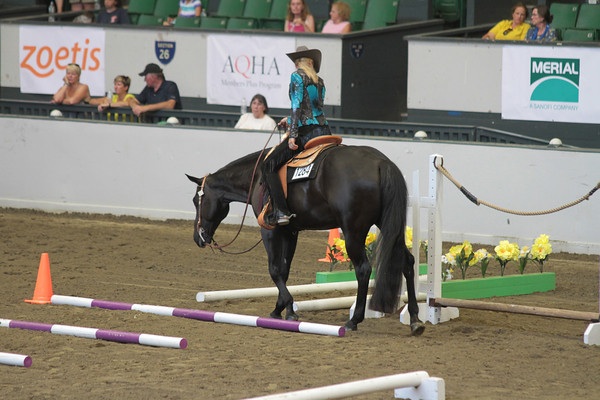Dial in your eyes: Trail exercises from Pro Troy Green & Torey Roderick
By Torey Roderick & Troy Green
 The winter months can be a great time for learning new skills, or honing and perfecting skills that are already in your arsenal. Sometimes a little challenge can break the monotony in the wintertime, whether for the trainer or the student. There is a trail exercise we came up with for developing a more educated eye among our students. I want riders that can walk into a warm up or show arena, look at the poles on the ground and tell me what the situation is. I want them to be able to assess what they see and adjust accordingly. The point of this exercise is teaching the riders to assess and adjust.
The winter months can be a great time for learning new skills, or honing and perfecting skills that are already in your arsenal. Sometimes a little challenge can break the monotony in the wintertime, whether for the trainer or the student. There is a trail exercise we came up with for developing a more educated eye among our students. I want riders that can walk into a warm up or show arena, look at the poles on the ground and tell me what the situation is. I want them to be able to assess what they see and adjust accordingly. The point of this exercise is teaching the riders to assess and adjust.
I take four (or more) poles and lay them out in a row so they are all parallel and at six-foot intervals to start, so they can be jogged or loped over. I ask the rider to assess the situation as they ride towards the poles. “Tell me what you see.” Jog-overs or lope-overs would be a correct answer, and ‘both’ would be an even better answer. I like options. I want them to make several passes at both gears over the poles. Then, I ask them to ride to the other end of the arena while I make adjustments. They can come back at either a lope or a jog and the goal is that they can assess as they approach and make adjustments while in motion.

There are lots of ways we can get creative and play with the poles on the ground as the riders approach. In one lesson, I rolled the poles in by four or five inches, making the line tighter. I asked my first victim to assess as she approached… about four strides out, she informed me that the line was short. I was impressed that she was catching on quickly. Next time around I rolled the first pole in the sequence out about eight inches (four inches back to where it was and then another four inches after that). As she loped up to the new scenario, she yelled to me, “Long, short, short.” She was catching on, but I fooled her on the next one. I adjusted the first three poles to be at normal six-foot intervals, and then rolled the last one out 12 feet. As my rider approached her eyes got big, and she yelled to me but never waivered as she drew near, “The last pole is REALLY long!” I laughed and assured her that it was in fact so long, she may want to add another stride. She laughed that she had over thought that one, and rode through the new scenario a few times.
I continued to move poles in and out and have her trot and lope the different scenarios. I spun one pole as if it had a pin through the very center. The only way to get through the line clean was to ride dead center. Sometimes in warm-up rings and occasionally even while showing, if the ring crew misses, we’ll have to navigate over less than-ideal conditions. My rider identified the crooked pole and told me she would have to hit center as she approached. She had been mostly loping the different scenarios I was throwing at her, and the last one nearly got her… I rolled all four poles in to three-foot intervals (otherwise known as jog-overs!) as she loped up at a steady pace she said, “REALLY tight line!” I stopped her before she tried to lope through and explained that I had tricked her, they were jog-overs, and please don’t lope through them. We had more laughs and continued moving poles around.

The point of the exercise was to get her thinking and it had. I want riders that (eventually) I don’t have to tell what poles they can trot or lope or walk over. I want them to be able to navigate through busy warm-up pens or even the arena at home and make full use of the poles. I want their eyes to be able to adjust and see a long line or a short line and know if their horse is coming in too forward or too slow. Skills like this can help a rider; maybe they’ll hit the first pole in a line, but if they know how to read a scenario and adjust, it could make the difference between a –half-point penalty for one hit, or a two-point penalty for hitting all four poles in a line. This exercise has proved to be a fun wintertime (or any time!) activity to break the monotony and get the wheels turning, while keeping both student and instructor actively involved.
